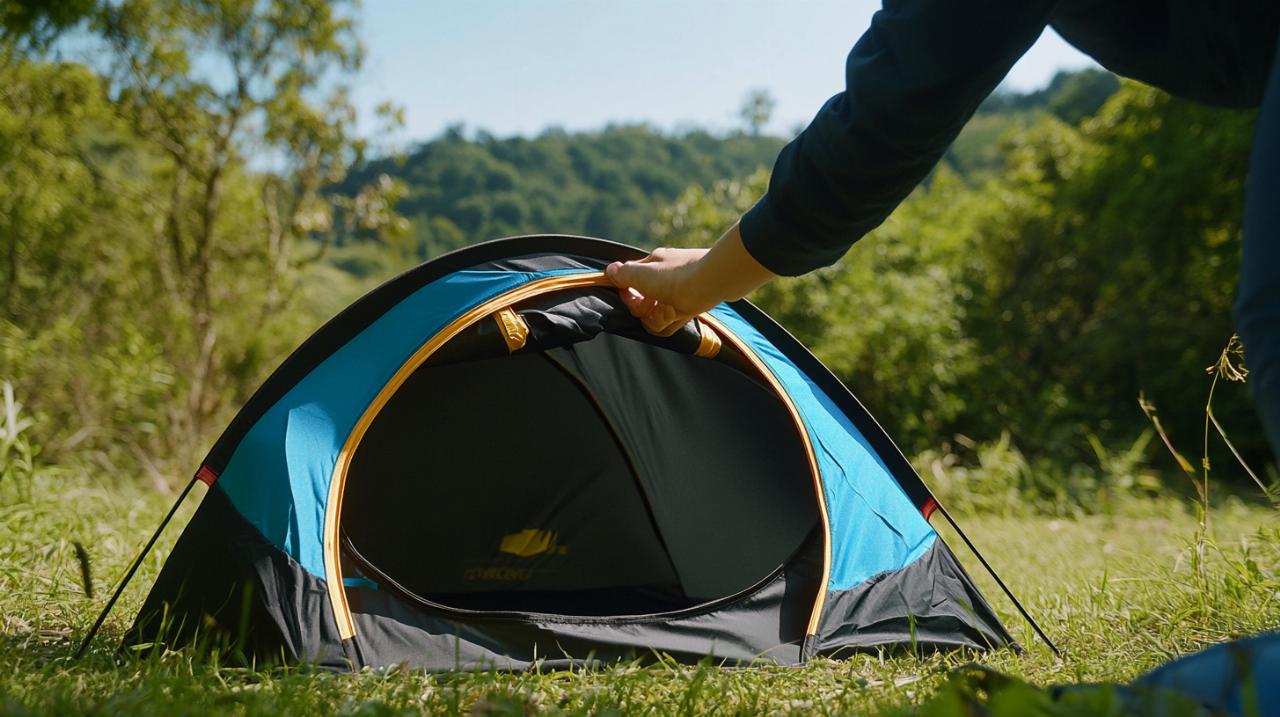Right then, fancy a weekend in the great outdoors? Ace! But wrestling with the tent at the end of your trip can be a proper nightmare. No one wants to spend hours fumbling with tent poles when there's a cuppa waiting at home. This guide will walk you through folding your Quechua 2-Second tent back into its bag without chucking a wobbly.
Preparing your tent for pack-up
Cleaning and Clearing the Tent Area
Before you even think about folding your pop-up tent, take a moment to give it a proper once-over. Make sure the canvas is relatively clean and free of mud and debris. Nobody wants to bring the garden back into their car, do they? Use plain or soapy water to clean any particularly mucky spots, giving it a good rinse afterward. This bit of maintenance goes a long way in preserving your tent's waterproof qualities and preventing that musty smell that develops when you store damp camping gear.
Gathering all tent components
Next up, make sure all your tent pegs are accounted for. Give them a quick wipe if they're mucky. It's quite annoying to find yourself short a peg on your next camping adventure. Collect any guy ropes that might be strewn about and check that all zips are working properly. This is also the perfect time to open up all the doors and windows of the tent. This lets the air out as you fold it, making the whole process much easier and preventing that vacuum-sealed balloon effect that can make folding seem impossible.
Mastering the 2-second tent folding technique
The figure-of-eight folding method
Now comes the tricky bit that makes many campers groan. Spread the tent out flat on the ground, trying to smooth out any major creases for a neater fold later. Locate the two main poles and the loops on either side of your 2 Seconds Easy Tent. Hold one loop in each hand firmly but gently. The secret is in the twist: bring your hands together, manipulating the tent into a figure-eight shape. This might take a couple of goes at first, but you'll soon get the hang of it. Don't force the tent poles too much; gentle pressure is all that's needed to guide them into place. Remember that these Decathlon tents are designed with clever folding technology, so there is a knack to it.
Stacking and securing your folded tent
Once you've mastered the figure-eight shape, stack one loop on top of the other. Your tent should now resemble a flattened disc. This is where many go wrong by not properly securing the folded tent. Use the strap provided to wrap tightly around the folded tent, keeping everything in place. Without this crucial step, your tent might spring back open just as you're trying to slip it into its bag. Next, give the folded tent a bit of a wiggle to coax it back into its transport bag. It might be a bit of a squeeze the first time, but it will fit! Honestly! The satisfaction of zipping up that bag with your neatly folded tent inside is well worth the effort.
Common folding challenges and solutions
Dealing with Wet or Muddy Conditions
British weather being what it is, you'll likely face the challenge of packing away a wet tent at some point. If the canvas is wet, try to dry it as much as possible before packing it away to prevent mildew. Shake off excess water and wipe down what you can with a towel. Sometimes you simply have to pack up in the rain. In this case, make a mental note to unpack and fully dry your tent as soon as you get home. This is particularly important for Fresh & Black tents, which use special technology to reflect sunlight and keep the interior cool and dark. The effectiveness of this feature can be compromised if the tent is stored damp, potentially leading to mold that damages both the waterproof coating and the reflective properties.
Troubleshooting difficult folds
If you find yourself struggling despite following all the steps, there are a few common mistakes to check for. First, ensure you're laying the tent completely flat before attempting to fold. Many people try to fold the tent while it's still somewhat three-dimensional, making the task unnecessarily difficult. Another common error is creating an incorrect figure-eight shape. The loops should be even and symmetrical. If one side is larger than the other, your tent won't fold neatly. Lastly, if the poles seem resistant to bending, you might be applying force in the wrong direction. The poles are designed to fold in a specific way, so if you meet strong resistance, stop and reassess rather than risking damage to your tent.
Tips for future camping success
Practising your technique at home
Practice makes perfect when it comes to folding your 2-Second tent. Have a go in your garden before you head off camping. This helps build muscle memory for the folding process and reduces the stress of packing up at the campsite. You might feel a bit daft doing tent drills in your back garden, but it's better than looking flustered at the campsite. Consider watching a video tutorial while you practice, pausing and rewinding as needed to master each step. You can also enlist a friend or family member to help, turning it into a teamwork exercise that will serve you well on actual camping trips.
Proper storage between camping trips
Once you're back home, proper storage is essential for maintaining your tent in tip-top condition. Always ensure your tent is completely dry before storing it away. Even a small amount of moisture can lead to mildew, which not only smells awful but can also damage the waterproof coating of your tent. Store your tent in a dry, room-temperature place, away from direct sunlight which can degrade the fabric over time. Consider applying a waterproofing spray once a year to maintain water resistance, especially if you camp frequently in wet conditions. If your tent has seen better days, remember that Decathlon offers repair services at their workshops, including pole replacement and flysheet repairs. Alternatively, if you're ready for an upgrade, you can sell your current tent on Decathlon's Second-hand platform, giving your faithful shelter a new lease of life with another camping enthusiast.
Extending the Life of Your 2 Second Tent
Fancy a weekend in the great outdoors? Brilliant! But anyone who's owned a pop-up tent knows that while pitching might be a doddle, packing it away can be a right faff. Quechua's 2 Seconds Easy Tent from Decathlon has revolutionised camping with its quick-pitch design, but proper care ensures your tent remains a faithful companion for many adventures to come.
Before we dive into maintenance and repairs, let's quickly recap how to fold your 2-second tent properly, as incorrect folding is often the culprit behind premature wear and damage:
1. Start by removing all tent pegs and laying the tent completely flat
2. Locate the two main poles
3. Bend the poles to create a figure-eight shape (this is the trickiest bit!)
4. Overlap the loops to form a circle
5. Secure the folded tent with the provided strap or clip
6. Tuck the folded tent into its bag
Many campers make common mistakes when folding these tents, such as not laying the tent flat first, forcing the poles too aggressively, forming an incorrect figure-eight shape, or neglecting to properly secure the folded tent. These errors can strain the poles and fabric, shortening your tent's lifespan.
Essential maintenance for pop-up tents
Proper maintenance is crucial for keeping your 2 Seconds Easy Tent in tip-top condition throughout the camping season and beyond. Before each camping trip, thoroughly check your tent for any damage including holes, broken poles, or faulty zips, and give it a good airing to eliminate musty odours.
When pitching your tent, select a flat, clear area away from water sources and sheltered from strong winds. For the Fresh & Black models, position the tent to take advantage of their special technology that reflects sunlight to keep the interior cooler and darker during bright mornings.
Condensation is a common issue in tents that can lead to dampness and mildew. To minimise condensation, always open the tent vents, avoid creases when pitching, and don't set up too close to water sources. These simple steps can dramatically reduce moisture build-up inside your tent.
After your camping trip, cleaning is vital. Use plain or slightly soapy water to clean your tent, and rinse thoroughly afterwards. Always ensure your tent is completely dry before storing it in a dry place at room temperature. Applying a waterproofing spray annually helps maintain the tent's water resistance, especially important with the British weather!
Repairing minor damages and wear
Even with meticulous care, wear and tear is inevitable after multiple camping trips. Small rips, broken guy ropes, and bent tent pegs are all fixable issues that needn't spell the end for your trusty shelter.
For minor tears in the flysheet, repair patches or waterproof tape can provide a quick fix. Bent tent pegs can often be gently hammered back into shape, though it's wise to carry spares. If your guy ropes have seen better days, replacing them is straightforward and inexpensive.
More significant issues like damaged poles or substantial flysheet damage might require professional attention. Decathlon offers workshop services for pole replacement and flysheet repairs. Alternatively, they provide spare parts and video guides for the DIY-inclined camper.
When storing your tent between trips, keep it in its bag in a cool, dry place away from direct sunlight. Storing a damp or dirty tent is asking for trouble—mildew and mould can take hold quickly, leading to unpleasant odours and potentially compromising the waterproof coating.
If you're upgrading your camping gear and no longer need your 2 Seconds tent, consider selling it through Decathlon's Second-hand platform rather than binning it. This extends the tent's useful life and is kinder to the environment.
With proper folding technique, regular maintenance, and prompt repairs when needed, your 2 Seconds Easy Tent will provide reliable shelter for countless adventures across the British countryside and beyond.







